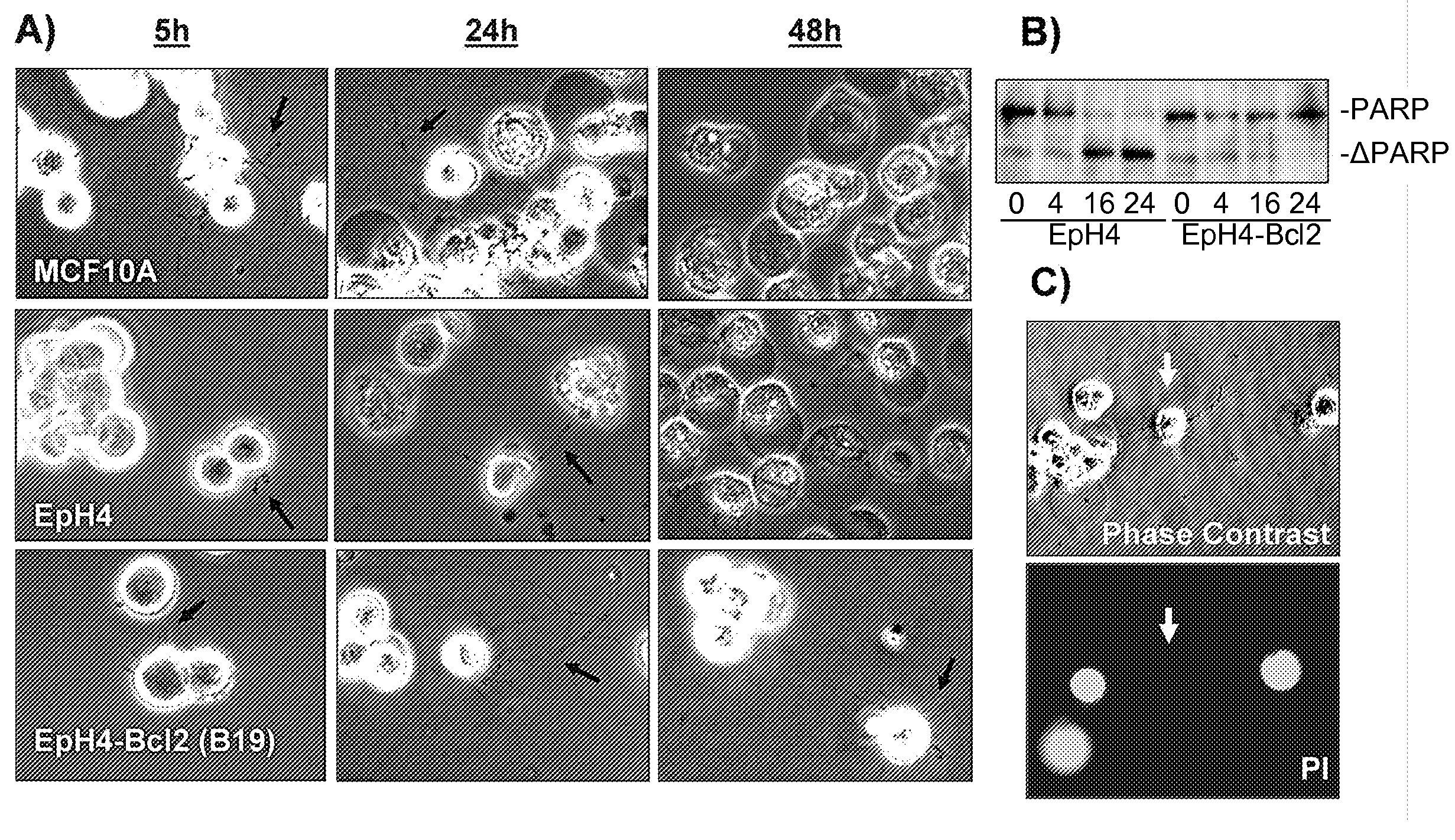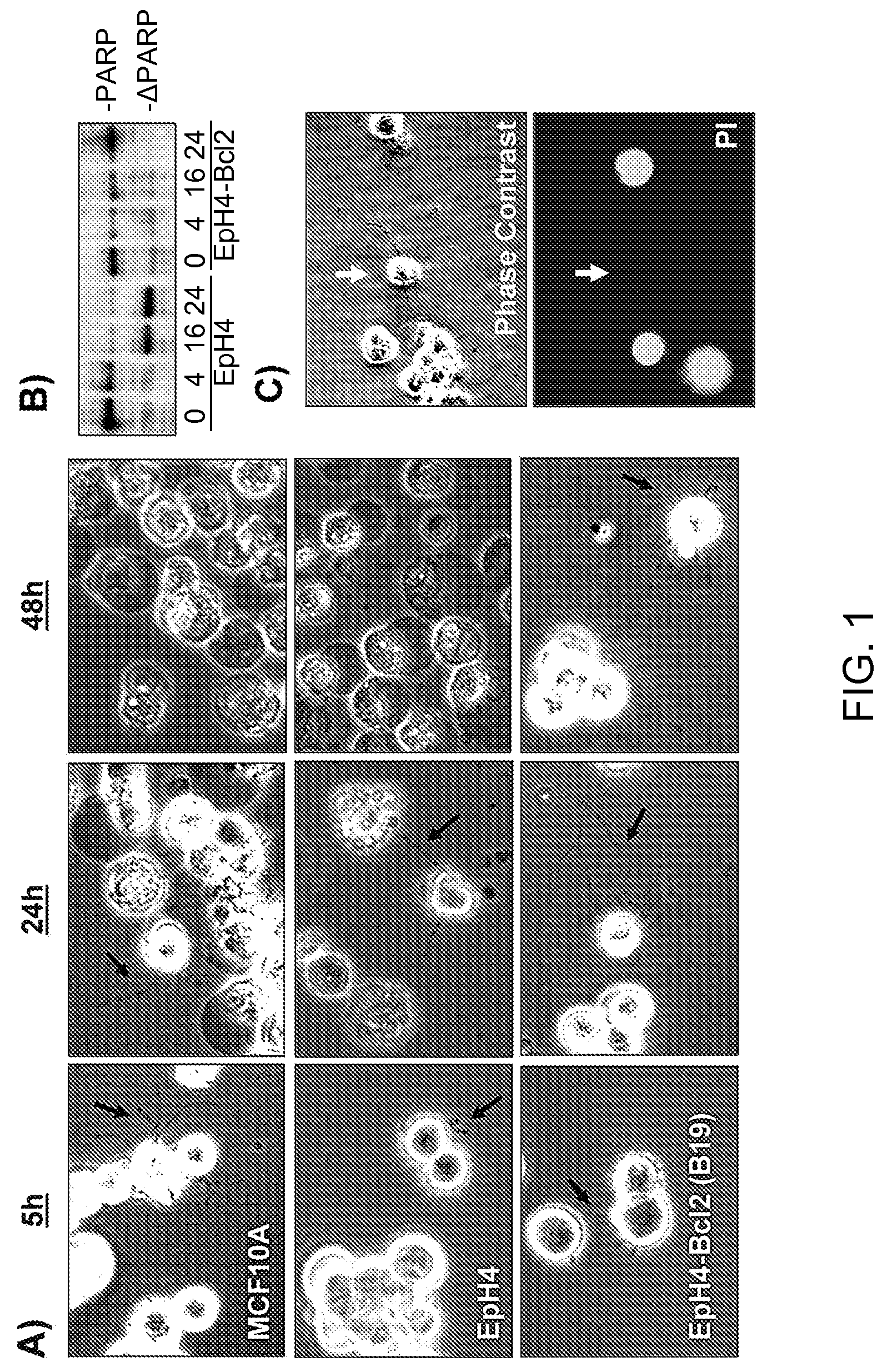Inhibition of microtubule protrusion in cancer cells
a cancer cell and microtubule technology, applied in the field of cell biology, molecular biology, cancer, etc., can solve the problems of resistance to apoptosis cell death not necessarily preventing early stress response, specific role of microtubules in this process, and currently not well-characterized, so as to reduce microtentacles and increase crosslinking in the actin cortex
- Summary
- Abstract
- Description
- Claims
- Application Information
AI Technical Summary
Benefits of technology
Problems solved by technology
Method used
Image
Examples
example 1
Exemplary Materials and Methods
[0223]This example provides exemplary materials and methods for use in the invention, although the skilled artisan is aware of other materials and methods that are sufficiently suitable.
Exemplary Cell Lines and Materials
[0224]MCF10A human mammary epithelial cells were kindly provided by Fred Miller and Robert Pauley of the Barbara Ann Karmanos Cancer Institute (Detroit. Mich.) and are a high-passage clone designated MCF10A1. MCF10A cells were grown in DMEM / F12 (Gibco) supplemented with 5% horse serum, insulin (5 μg / ml), EGF (20 ng / ml), hydrocortisone (500 ng / ml), penicillin-streptomycin (100 μg / ml each), and L-glutamine (2 mmol / L). EpH4 mouse mammary epithelial cells and those stably expressing pcDNA3.1-Bcl2 (B19) were previously described (Pinkas et al., 2004; Lopez-Barahona et al., 1995), and maintained in DMEM (Gibco) supplemented with 10% bovine calf serum, penicillin-streptomycin (100 μg / ml each), and L-glutamine (2 mmol / L). For all inhibitor and ...
example 2
Characterization of Microtubule Protrusions and Inhibition Thereof
[0230]When detached from extracellular matrix, the nontumorigenic MCF10A human mammary epithelial cell line and EpH4 mouse mammary epithelial cell line produce protrusions of the plasma membrane (FIG. 1A, black arrows). Time-lapse video microscopy detects rapid motion in these protrusions and transient probing contact with surfaces. This response is short-lived, as EpH4 or MCF10A cells die efficiently by apoptosis within 24 hours following detachment (Pinkas et al., 2004; Martin and Leder, 2001), and complete cellular fragmentation by 48 hrs. terminates these protrusions (FIG. 1A). However, when EpH4 cells were used that overexpress Bcl-2 (B 19) and are highly resistant to apoptotic challenge (Pinkas et al., 2004), many of the cells remain intact after 48 hours and continue to generate protrusions (FIG. 1A). Similar resistance and protrusions are observed in EpH4 or MCF10A cells overexpressing either Bcl-2 or Bcl-xL (...
example 3
Protrusions are Increased in Metastatic Breast Tumor Cell Lines
[0235]FIG. 7 shows that metastatic breast tumor cell lines have more frequent and numerous protrusions. The nontumorigenic human mammary epithelial cell line (MCF10A) or the indicated human breast tumor cell lines were grown in suspension for 30-60 minutes, and protrusions were counted in random fields with phase-contrast microscopy. Values represent the mean±S.D. of three experiments in which at least 100 cells were counted. Treatment of MCF10A cells with the exemplary actin inhibitor, Latrunculin-A (LA, 5 mM), increases protrusions, as observed previously. Human tumor cell lines show high levels of protrusions even in the absence of LA treatment, indicating that depolymerization of actin is not required for tumor lines to produce microtubule protrusions. In addition to more frequent protrusions, metastatic tumor cell lines often displayed a greater number of protrusions per cell. This effect was most apparent in the hi...
PUM
| Property | Measurement | Unit |
|---|---|---|
| Mass | aaaaa | aaaaa |
Abstract
Description
Claims
Application Information
 Login to View More
Login to View More - R&D
- Intellectual Property
- Life Sciences
- Materials
- Tech Scout
- Unparalleled Data Quality
- Higher Quality Content
- 60% Fewer Hallucinations
Browse by: Latest US Patents, China's latest patents, Technical Efficacy Thesaurus, Application Domain, Technology Topic, Popular Technical Reports.
© 2025 PatSnap. All rights reserved.Legal|Privacy policy|Modern Slavery Act Transparency Statement|Sitemap|About US| Contact US: help@patsnap.com



